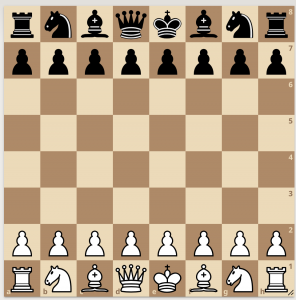By CEO National Master Evan Rabin

Dan Lucas, US Chess Senior Director Of Strategic Communications, frequently posts on social media about how chess boards in films are set up incorrectly. Often, the board is sideways, as the lower right hand corner is not a light square. Before starting a game, it is important to double check that the board is set up correctly. The first round at all  of our tournaments, the boards are set up properly as our directors do it. Sometimes during round 2, there might be some mishaps as we tell the players to reset their pieces after their first game. As long as
of our tournaments, the boards are set up properly as our directors do it. Sometimes during round 2, there might be some mishaps as we tell the players to reset their pieces after their first game. As long as  one makes sure the lower right hand corner is light, white pieces are on ranks 1 and 2 (if the board has letter and numbers), and follows this order in setting up the pieces (which National Mitch Fitzko taught during a Chess in the Schools professional development meeting), one will always set up the board correctly:
one makes sure the lower right hand corner is light, white pieces are on ranks 1 and 2 (if the board has letter and numbers), and follows this order in setting up the pieces (which National Mitch Fitzko taught during a Chess in the Schools professional development meeting), one will always set up the board correctly:
- Set up the eight white pawns along the 2nd rank and the black pawns on the 7th rank.
- Put the rooks in the corners of the 1st and 8th ranks.
- Put the knights next to the rooks.
- Put the bishops next to the knights.
- Put the king and queen in the middle. Make sure the queen has a matching dress; the white queen goes on a white square and the black queen goes on a black square.
These are the most common mistakes I see when beginners set up the board:
- Setting up the board sideways; the lower hand color is a dark square.
- The white queen is on a dark square and vice versa; i.e they are on the “e” file.
- The knights and bishops are switched with the white knights on c1 and f1, black knights on c8 and f8, white bishops on b1 and g1 and black bishops on b8 and g8.
When players set up the board incorrectly, they are playing some variant of chess but not the real game.  That is why US Chess rules state that if less than 10 moves are played, and one player realizes that the board was set up in correctly, they need to restart the game from the beginning. A few years ago, I was running a tournaments and a bizarre scenario happened:
That is why US Chess rules state that if less than 10 moves are played, and one player realizes that the board was set up in correctly, they need to restart the game from the beginning. A few years ago, I was running a tournaments and a bizarre scenario happened:
A child was one move away from checkmating his opponent; unfortunately for him, his opponent realized the board was set up incorrectly and only 9 moves were played. I went over to see what happened and knew the rule was they would have to restart the game. I felt bad for the child who was one move away from checkmate; I confirmed with our Chief Tournament Director Harold Stenzel that the game should be restarted, even though he was so close to checkmate and Harold agreed it should. Shortly after, the child who was a few moves away from checkmating ended up losing their ‘second game’ which counted and started crying. Unfortunately, he learned the lesson that it is important to make sure the board and clock are set up correctly before the game begins the hard way. Similarly, I have seen many experienced players get into time pressure and only then realize that the clock was not set up with time delay. Know the rules before you go and make sure the board and clock are set up correctly before your next game.


It’s a game. Five dollars is free. Try it It’s not an easy game
토토사이트 ->->
It’s a game. Five dollars is free. Try it It’s not an easy game
카지노 검증업체 ->->
It’s a game. Five dollars is free. Try it It’s not an easy game
토토사이트 ->->
Enter a world of endless possibilities!
Great advice! It’s crucial to start with a correctly set up board and clock to avoid unnecessary complications later in the game. The story about the child’s near-victory really drives home the importance of double-checking before the game begins. Paying attention to these details can make all the difference
The DeepNude AI tool from Undress.app allows users to create AI-generated nude images by removing clothing from photos. It offers various modes and settings, ensuring high-quality, realistic results using neural networks and GAN technology. The platform is user-friendly, provides a free trial, and supports multiple payment methods. It emphasizes safety, confidentiality, and privacy, while offering a referral program for earning credits. The tool is widely used and marketed for both casual and more advanced users.
Being an experienced chess player I much appreciate such posts. Thank you for teaching new people!
At best-undress-ai.app, users can select from a variety of AI Undressing Tools designed to undress anyone. The platform features multiple options, allowing users to find the most effective tool suited to their needs. With user-friendly navigation and clear descriptions, it ensures that everyone can easily identify the best solution for their specific requirements, making the process straightforward and efficient. Experience the convenience of choosing the right tool for your preferences.
The site [Link deleted]offers a curated selection of the best nudify apps available. Users can easily find and choose applications designed to undress images of any girl. With detailed reviews and comparisons, the platform helps users make informed decisions about which nudify app suits their needs best. Whether for fun or artistic purposes, this site serves as a valuable resource for those interested in nudification technology.
Thank you for the useful information that I rarely find on the sites
I have benefited a lot from this information
I am so happy to read this. This is the kind of manual that needs to be given and not the random misinformation that is at the other blogs.
Even simple wooden puzzles and eco-blocks are designed to be safe, durable, and free from harmful chemicals, making them a healthier choice for toddlers and young children. Parents who care about giving their children the best while also protecting the planet find these toys to be the perfect solution. The popularity of eco-friendly toys in 2025 proves that learning doesn’t only happen in books or screens—it can also come from understanding how our choices affect the earth.
Outstanding quality and expert support define this team’s approach, ensuring every client’s goals are achieved.구글찌라시 With a focus on precision and client goals, this team provides solutions that are both effective and sustainable.
Every interaction reflects their dedication to delivering superior results and building lasting professional relationships.강남쩜오 Their proven track record and expert knowledge make them a dependable choice for anyone seeking excellence.
I consider this one of the most valuable pieces of information I’ve come across, and I’m truly pleased to have read your article. It provided meaningful insight, and I appreciate the effort you put into creating it. That said, I’d like to point out a few minor issues that could be improved for an even smoother experience. Overall, the website looks impressive, the articles are engaging, and the quality of your work really stands out. Excellent job, and congratulations!
Love the way you explain things! So easy to understand.
My experience with Cricbet99 has been exceptional! The site is simple to navigate, and the Cricbet99 Login is fast and secure. With the Cricbet99 App, I can follow live action and stay connected anytime I want. The platform runs smoothly with no interruptions, making the whole journey enjoyable and effortless. Cricbet99 really delivers on speed and reliability.